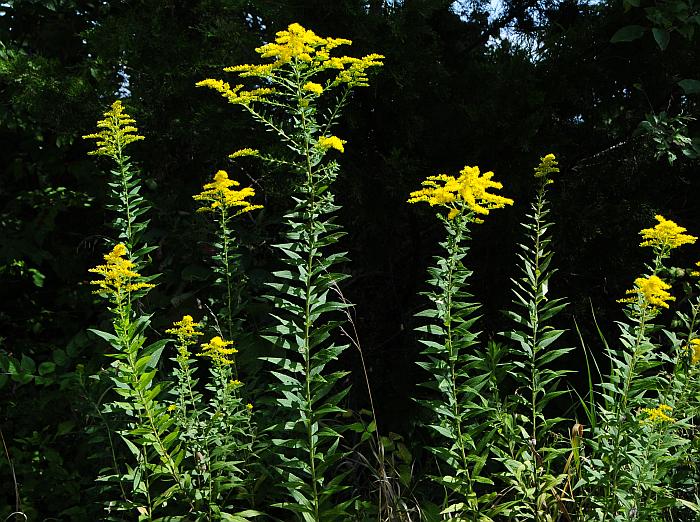Solidago altissima L.
Tall Goldenrod

Native
CC = Amb
CW = 3
MOC = 94
© SRTurner
Solidago altissima L.Tall Goldenrod | |
 |
Native CC = Amb CW = 3 MOC = 94 |
© SRTurner |
|
Family - Asteraceae/Astereae Habit - Rhizomatous perennial forb, often with thickened bases. Stem - Strongly ascending to erect, 1 to several, to 2.5 m (usually longer than 1 m), with several fine, longitudinal lines or grooves, moderately to densely pubescent with short, curved hairs, sometimes less densely hairy toward the base, not shiny, not glaucous.
Leaves - Chiefly cauline, the largest leaves in the lower 1/3-1/2 of the stem, the basal leaves usually absent at flowering. Basal and lowermost stem leaves with the blade 3-15 cm long, 0.5-2.5 cm wide, mostly 5-13 times as long as wide, narrowly oblanceolate to narrowly lanceolate, somewhat thickened and stiff, tapered gradually to a sessile or very short-petiolate base, tapered to a sharply pointed tip, the margins sharply toothed to nearly entire and usually roughened or minutely hairy, the upper surface moderately to densely pubescent with short, curved to spreading hairs or sparsely to moderately roughened with minute, bulbous-based hairs, the undersurface moderately to densely pubescent with short, spreading hairs (these also sometimes slightly bulbous-based), with 3 main veins, the lateral pair often originating well above the leaf base and finer than the midvein, the veinlets often difficult to observe, forming an irregular, dense network. Median and upper stem leaves 1-15 cm long, narrowly elliptic to narrowly lanceolate, sessile, the margins of the uppermost leaves often entire, otherwise similar to the lower stem leaves.
Inflorescence - Pyramidal panicles, the longer branches and often also the tip arched or nodding.
Heads - Numerous, oriented upward along inflorescence branches. Involucre 3.0-4.5 mm long, the bracts in 3-6 unequal series. Involucral bracts lanceolate, usually sharply pointed at the appressed- ascending tip, the margin sparsely hairy, the outer surface glabrous, usually entirely yellowish. Receptacle naked.
Florets - Ray florets 10-16, the corollas 3-4 mm long, yellow. Disc florets 3-7, the corollas 3.0-3.5 mm long, the lobes 0.5-0.9 mm long, yellow. Pappus 2.8-3.5 mm long, some of the bristles slightly thickened toward the tip.
Fruits - Achenes 0.6-1.2 mm long, narrowly obovoid, finely hairy. Flowering - August - November. Habitat - Prairies, upland forests, streambanks, pastures, fields, roadsides, open disturbed areas. Origin - Native to the U.S. Lookalikes - Other goldenrods, particularly S. canadensis and S. gigantea. Other info. - This is undoubtedly the most common and weediest of Missouri's goldenrods. It will grow in almost any sunny location, sometimes aggressively monopolizing fields. It is found throughout Missouri and across most of the continental U.S., except for the far western regions of the country. Photographs taken near Labadie, Franklin County, MO, 9-15-2019 (SRTurner). |